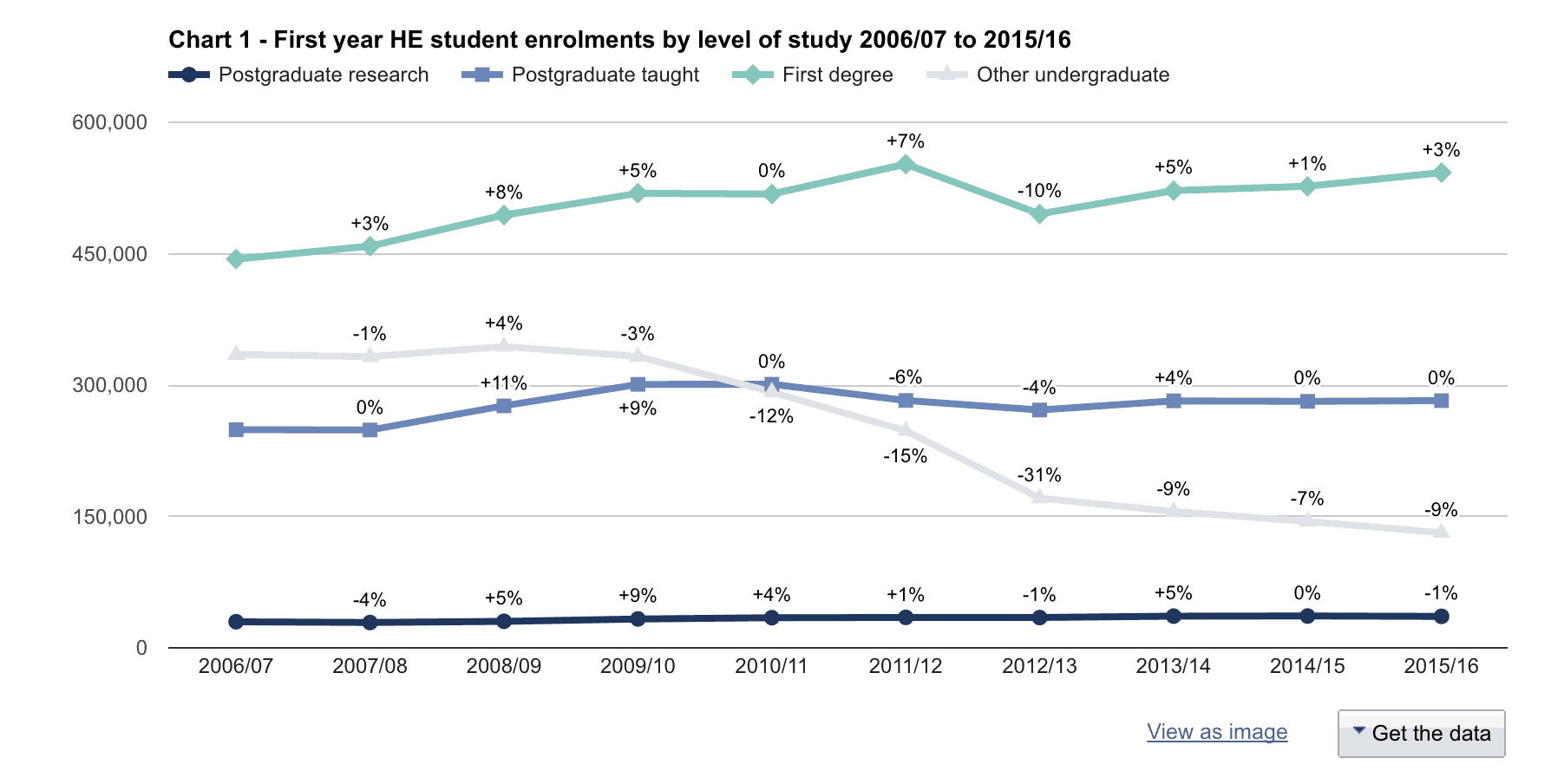When it rains, it pours. The Sunday Times is the latest to pile in on the sector with groundbreaking “analysis” showing “British A-level students are being ‘discriminated’ against by many of the UK’s top universities as they recruit more lucrative overseas applicants instead”.
In an odd front-page article the line of thinking from senior correspondent Andrew Gilligan (I’ve had too many suggestions from fellow wonks to make a joke about ‘sexing up’ figures) seemed to be thus:
- I clicked on the Higher Education Statistics Agency’s front page, and it shows that undergraduate student numbers have fallen since 2010!
- But HESA table 9a (XLS) shows non-EU international student numbers have risen! Are these foreigners “crowding out British students”?
- I’ve also heard about these ‘foundation courses’ which many international students take pre-entry. They don’t sound so robust…
- So it all makes sense now – universities are letting in undeserved foreigners over hard working British 18 year olds doing A levels.
This was news to me, and as it turns out, to many others of us who closely follow universities. Aggregate competition for limited places is no longer an issue at most universities, which have become recruiting rather than selective organisations since student number controls were abolished. International student recruitment has hardly been easy going since 2010.
But most of all, far from being crowded out, the proportion of British school leavers entering university is now at its highest ever level. The same goes for British school leavers holding A levels – again, at record levels in 2016.
So what’s happened here? Well, effectively, Gilligan used the wrong numbers, either because the right ones don’t fit the story he wants to tell, or because the story that they do tell is far less juicy (and more familiar). As became clear in a debate on Twitter between Gilligan and the Guardian’s Richard Adams, Gilligan is using different statistics to the rest of us, and is either being mislead by them, or trying to mislead.
Gilligan compared national and institutional overall student numbers between 2008/09 and 2015/16. These show three things:
- Overall undergraduate numbers have declined, from 1.86 million to 1.75 million.
- British undergraduate numbers have declined, from 1.67 million to 1.51 million.
- Non-EU undergraduate numbers have increased, from 112,000 to 156,000.
But overall undergraduate numbers are not to be confused with those doing their first degrees full-time – usually school leavers – as Gilligan heavily implies in his article. If we look at the number of first degree undergraduates over the same period, we find the following:
- First degree numbers have increased, from 1.35 million to 1.56 million.
- British first degree numbers have increased, from 1.2 million to 1.34 million.
- International first degree numbers have increased, from 93,000 to 143,000.
The missing link is in the massive decline in part-time and second degree undergraduates since 2008/09, the vast majority of whom are UK domiciles. This is shown clearly in this HESA graph:

When I confronted Gilligan about this on Twitter, his response suggested (to me at least) a realisation that a mistake had been made. He argued that his piece “was mainly about the fact that non-EU undergrads are admitted w/ lesser qualifications” and that we shouldn’t suggest that part-time and second degree students “don’t count”.
I wouldn’t suggest anything of the sort, but then again, neither did his article, which made precisely zero mentions of the massive decline in part-time and second degree students since 2008-09.
I shall not deign to assume whether this was conspiracy or cock-up. I have some sympathy for Gilligan if it was the latter. HESA’s website is not the easiest to use, and one could easily look at overall undergraduate numbers and make an assumption about a story that simply isn’t there. I would urge HESA to make finding historic data more ‘journalist friendly’ for hacks with a deadline. To write this piece I have had to have six different tabs open on HESA’s website, plus three different Excel sheets and the HESA mobile app. No wonder mistakes can be made.
A lower standard
Whilst the HESA data may not tell the story that Gilligan wishes it did, there is still the question over entry standards for international students to be answered. Others are much better placed to answer it than I am, but I’ve been surprised to see comparatively little push back by the sector defending universities’ arrangements with organisations such as INTO and Study Group. This is also not the first time questions have been asked about the efficacy of English language testing in ensuring sufficient aptitude for higher-level study.
Perhaps this is why the sector’s PR machine is keeping its head down? Or is everyone just on holiday? Meanwhile, a disastrous streak of news stories for higher education continues apace.
Update (3pm, 7/8/17) – HESA has published a helpful clarification of its own on with a further breakdown of what the data tells us. It clearly shows that whilst British full-time first degree students increased by 17% between 2008/09 and 2015/16, part-time first degree student numbers fell by 13%, and ‘other undergraduate’ (i.e. not bachelor’s degree students, or second bachelor degrees) fell by an astonishing 65%!













Good work on the data – maybe if Gilligan had spoken to someone in the sector they’d have sense-checked this (but no, he spoke to Andrew Adonis)
Foundation courses are entirely reputable* and do a variety of different jobs. That may be why it’s hard to come out and defend them across the board – plus there are versions for UK students (just to puncture another misconception)
*I’ve worked at universities that have had in-house versions, and they were all doing a decent job of preparing students for either UG or PG study.
I think he has also confused domicile on entry, with fee eligibility, as well as using the All UG figures (and not just first degree), and all modes of study, (and not just FT).
[The quickest way of working on this data is via HeidiPlus, with a quick check to HESA’s published data, which saves on having 6 tabs open to do the comparisons]
HeidiPlus is indeed good. But it costs.
Sounds like one of those intentional mistakes made in service to a political agenda, maybe the Sunday Times should of published it on the side of a bus
Good article David, the current spate of ignorant and uninformed ‘university-bashing’ is getting out of hand. Re the data access HeidiPlus is unfortunately not accessible to people outside universities , so journalists certainly would not have access. (We are HE analysis specialists but we are also are barred from access -even if the cost was not prohibitive for a micro firm, – which it is. Shame, as this is a barrier to carrying out a good deal of informed analysis .)
Good point, particularly the FT/PT issue. Displaying my ignorance, does the term ‘second degree undergraduate’ mean something other than a student who has completed a degree and is taking another UG degree in a different subject ? Some HEPs don’t have much activity in what would map from a HESA course aim to the OUG category and it sounded as if you were including second first degrees in there which confused me.
Judging by his twitter feed he’s accepted nothing. Also isn’t it widely discussed that changes to student funding has affected part time and non traditional applications?
I agree with the broad point, but the author of this article also seems to be a little confused on what “first degree” means in HESA-ese. It actually refers to the level of the qualification, not whether this is the first degree the student has studied. All bachelor’s degree students (plus a few others on ‘undergraduate masters’ programmes like MEng) are classed as First Degree, regardless of whether they’ve already completed a degree in the past.
If that’s the case, Kevin, who are the ‘other undergraduates’ in the HESA data?
@Stuart “Other undergraduate” mostly refers to sub-degree qualifications – Diploma (DipHE/HND), Certificate (CertHE/HNC), foundation degrees and the like.
I think this article is a bit misleading on the basic data front – the other significant part of the HESA clarification (not directly quoted above) is that : ‘The number of non-EU domiciled students on first degrees has increased significantly, from 92,620 to 143,300.’ I don’t personally agree with the spirit of the Times article, but I don’t think you emphasise the worst bit of ‘data analysis’ above, namely the un-evidenced leap that was made – there is no way in an uncapped places environment that HESA data alone could give any indication that international students are ‘taking places’… Read more »